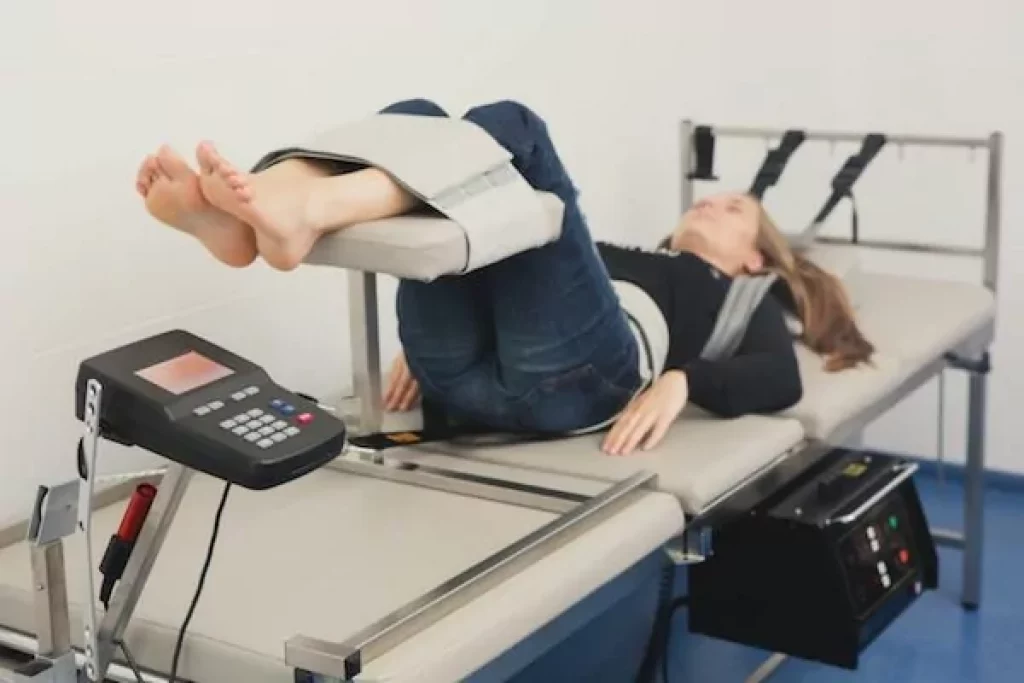Do you constantly struggle with back and leg pain? You know how debilitating it can be if you have chronic back pain.
Back and leg pain can affect every aspect of your life and make it difficult to perform everyday tasks. Luckily there are ways to relieve your back pain without surgery or drugs.
If you’re looking for a way to relieve your back and leg pain, then spinal decompression therapy might be the solution you’re looking for. Continue reading to learn more about this incredible option.
What is Nonsurgical Decompression Therapy?
When it comes to decompression therapy, you have two options: Nonsurgical and surgical decompression therapy. But, first, talk about nonsurgical decompression therapy, a non-invasive alternative.
This motorized traction can help relieve back pain by gently stretching your spine. The change gently takes the pressure off of your spinal disks. These are gel-like cushions between the bones in your spine.
By relieving the pressure on your disks, you also take the stress off nerves and other parts of your spine. As a result, bulging or herniated disks have a chance to retract and relax.
This also helps water, oxygen, and nutrient-rich fluids flow more easily into the disks and promotes healing.
If you’re unsure where to go for treatment, you can find out more about our services on our site.
Who May Need Nonsurgical Decompression Therapy?
This type of decompression therapy may be helpful for people with neck pain or sciatica. This treatment can relieve the pain, weakness, or tingling that extends down the leg due to these issues.
People with bulging or herniated disks and degenerative disk disease may benefit from this therapy.
Spinal decompression can be a treatment option if you have worn spinal joints, also known as posterior facet syndrome, and other injuries or diseases associated with your spinal nerve roots.
What Happens During Nonsurgical Spinal Decompression?
Want to know what to expect when receiving spinal decompression therapy? It’s a simple procedure that is done entirely clothed. Typically this procedure is performed by back pain specialists as well as chiropractors.
Your doctor will fit you with two harnesses—one around your pelvis and another around your lower back. Next, you will be asked to lie on a computer-controlled table, either face down or face up.
Your doctor will customize your treatment through the computer to meet your specific needs. For example, the mechanical table will stretch out your spinal discs to create negative pressure on your lower back.
You can expect your treatment to last from 30 to 45 minutes. Typically decompression therapy requires 20 to 28 treatments over five to seven weeks.
Your doctor may use decompression therapy as part of a treatment plan that includes electrical stimulation to specific muscles, ultrasound, and heat or cold therapy.
These treatments work together to promote healing in your back and muscles.
Who Should Not Have Nonsurgical Spinal Decompression Therapy?
Not everyone is a good candidate for this therapy. For example, you shouldn’t have decompression therapy if you are pregnant.
Other reasons to avoid this treatment are fractures, tumors, abdominal aortic aneurysms, advanced osteoporosis, or if you have metal implants in your spine.
What is Spinal Traction Therapy?
Just like spinal decompression therapy, spinal traction therapy is also used to create space between your vertebrae. This will help stretch your spin and take the pressure off your lower back and any pinched nerves. This can ultimately help relieve pain.
What is Surgical Spinal Decompression?
For certain types of back pain, surgical spinal decompression is an option. Although, this is usually used as a last resort. Your doctor may recommend surgery for bulging or ruptured disks, bony growths, or other spinal problems.
Types of Spinal Decompression Surgery:
Depending on your specific situation, your doctor may advise you to have one of these common types of surgery.
Corpectomy: The removal of a vertebral body and disks between your vertebrae.
Discectomy: When a portion of your disc is removed to relieve pressure on your nerves.
Foraminotomy or Foraminectomy: A surgeon removes bone and other tissue to relieve pressure by increasing the opening for nerve roots.
Laminotomy or Laminectomy: A surgeon removes a small portion of bone, such as a section of a bony arch or the entire bony arch. This is meant to increase the size of the spinal canal to relieve pressure.
Osteophyte Removal: When bony growths are removed through surgery.
These types of surgery aren’t for everyone and should only be considered after all other avenues have been explored.
Surgery Comes with Risks
Surgery is a last resort for spinal decompression because it also comes with higher risks. These include infection, bleeding, blood clots, an allergic reaction to anesthesia, and nerve or tissue damage.
There’s also a chance that your back pain may not improve after the surgery. Therefore, it is difficult to know if you will find spinal decompression surgery beneficial.
Is Spinal Decompression Therapy Right for You?
Using spinal decompression therapy to relieve pressure in your back can be an effective way to feel better and manage your chronic pain. However, remember that this therapy works best with other treatments and is not an instant cure.
It is a fantastic tool that can help people who suffer from back pain to find relief and healing. If you haven’t tried this therapy, you should consider fitting it into your regular pain relief routine!
Over time decompression therapy has been known to elongate the spine, improve flexibility, ease back stiffness and muscle aches, improve blood circulation, and relieve nerve compression.
Talk to your doctor about spinal decompression therapy. Your spine will thank you for it!
